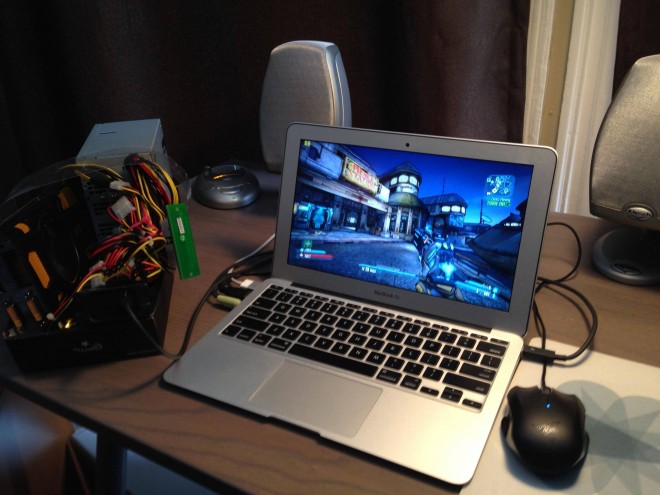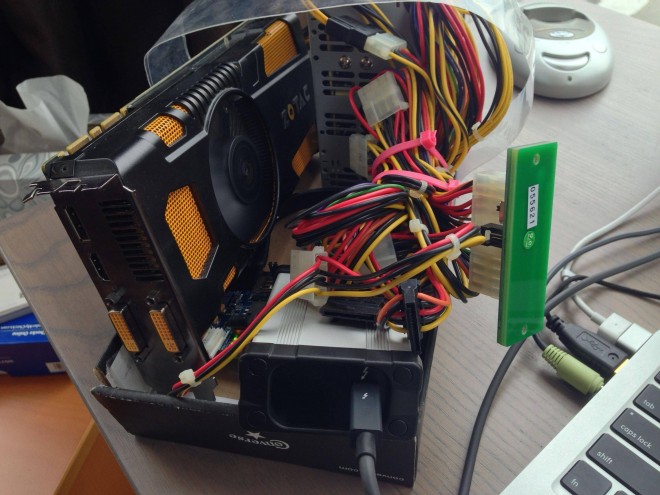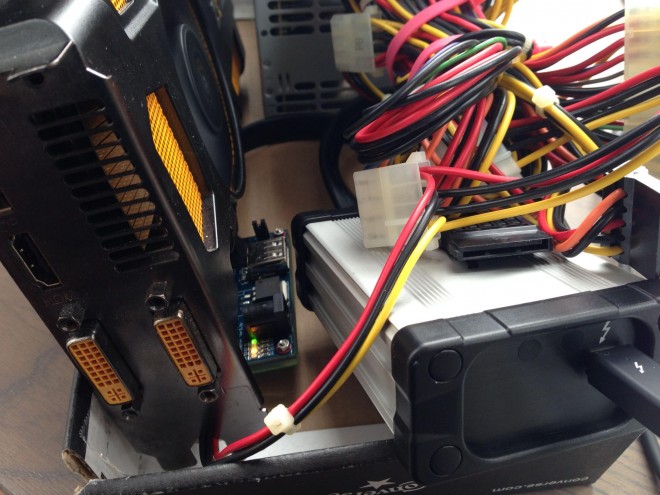
Since the advent of very high speed ports like Thunderbolt many have speculated as to when external graphics adapter cards are coming to laptops.
Well with $250 worth of parts it is possible to do already.
First of all it is worth pointing out clearly that this solution is a total hack and not a dummy-proof way of adding powerful NVidia graphics and CUDA to your Macbook.
If you need CUDA and ‘good enough’ graphics performance for Resolve I recommend the Macbook Pro Retina 15″ with NVidia 650M GT and 1GB of dedicated graphics DDR3.
This solution involves running Windows 7 on your MacBook Air and a PCI-Express desktop graphics card sat on top of an adapter and an external power supply. This isn’t an accessory you’ll want to put in a suitcase and travel with! Which begs the question – why not just use a desktop?
The more important thing here for me is that it PROVES high performance external desktop graphics can work via Thunderbolt and that laptops could soon get external NVidia or AMD solutions which you buy off a shelf and sit on your desk. If and when they come along – hopefully they won’t be mounted in a shoebox lid…

The 2013 MacBook Air has a Thunderbolt port and USB 3.0 (as does my MacBook Air which is a 2012 model) and the solution is to attach an Expresscard adapter for 5Gbps 2.0 PCI bus speeds to the Thunderbolt port and a further adapter from Expresscard to PCIExpress, then a lot of fuss to get the laptop to use this external graphics board instead of the puny integrated Intel chipset.
In this tutorial posted at Techniferno by a forum user you need the following parts to get it working:
Sonnet Echo ExpressCard Pro ($134 at B&H)
This adapts the 10Gbps Thunderbolt port on the MacBook Air to 5Gbps ExpressCard.
BPlus PE4L V2.1 ExpressCard to PCI-Express adapter ($70)
This is what the graphics card sits in. The tutorial points out you need to buy the full PE4L-EC060A package which includes a SWEX adapter to keep your external power supply turned on.
Thunderbolt cable ($36)
This allows the other adapters to sit somewhere convenient and not right next to your laptop.

400w PSU ($20)
The power supply is the same as that from a desktop PC and it is required by the NVidia graphics card.
Video card (i.e. NVidia GTX 570)
I have the GTX 570 in my desktop machine to edit uncompressed raw on using CUDA in DaVinci Resolve. It works well and doesn’t consume as much power as the GTX 580. I’m interested to see if the later models such as the 670 GTX work with this setup.
Now there are small things you need but all are required – software, such as DIY eGPU Setup 1.X for Windows, to get Windows to accept the external video card. It’s a bit like a drug for organ donor patients!
A USB memory stick for Bootcamp to install Windows off, and of course a copy of Windows 7 itself.
How does it perform?
Says Kolper at the Techniferno forum:
“As you’ll see by the benchmarks later in the article, yes you’re only running at expresscard 5Gbps x1 2.0 PCI bus speed (as opposed to 16X 2.0 on a proper PC and only half of Thunderbolt’s 10Gbps), but its WAY WAY better than the internal integrated graphics of the laptop”
I’m curious to see what performance is like with CUDA and video editing but the gaming frame rates are pretty impressive.
All said, I am amazed this works. Now give us an official solution NVidia! What are you waiting for?


